JUPITER, MARS, VENUS, THE SUN AND THE
MOON: HERALDS OF SN 1054?
Astronomers like Kepler were very interested in the massing of
planets, conjunctions and eclipses in relation to prognostications and the
subsequent appearance of comets and stella nova in those places. At the time
of SN 1604 many astronomers were waiting for a comet to materialise in the
region of Ophiuchus, the fact that it was a new star took everyone by surprise,
but some celestial event was expected. In ancient Greece Empedocles
described the universe in terms of positive and negative influences manipulating
the elements Fire, Earth, Air, and Water. Signs of the zodiac and planets were
assigned to each of these elements in groups of three that form a triangle on
the ecliptic. To fire; Aries, Leo, Sagittarius. To earth: Taurus, Virgo,
Capricorn. To air: Gemini, Libra, Aquarius. To water: Cancer,
Scorpio, Pisces. The planets were also assigned to the points but the actual
grouping vary somewhat. In 1603 Jupiter and Saturn, two of the firey
planets were in conjunction in one of the points of the fiery trigon,
Sagittarius which was not a common occurrence. The next year while these
planets lingered on the border of the firy trigon and Scorpio in Ophiuchus, Mars
would conjunct both planets in turn, Mars and Saturn then Mars and Jupiter.
This was a great omen of things to follow and only surpassed by a comet born
from the fire, and so they watched the sky for this great birth and what they
got was even greater than a comet it was a new star. The last conjunction
of Mars and Jupiter was on 9th October, the very next day SN 1604 was observed
by Brunowsky forming a tight triangle with Mars and Jupiter in the leg of
Ophiuchus, he reported it to Kepler but Kepler did not observe it himself until
17th October due to cloudy conditions. Given the suggested timeframe for
the writing of the Voynich Manuscript it would be interesting to consider what
someone from the 17th century with this type of background would make of the
massing of planets during the time of SN 1054 and no doubt this is something
that would have been looked at. Venus, Mars, Mercury, the Sun and the Moon seem to figure prominently in
Taurus and particularly in respect of the exact location of SN 1054.
Taurus is an earth point and Mars and the Sun are not earth planets but fiery
planets were connected in 1604 AD with the birth of comets. Just for
interest, below are charts of some planetary groupings leading up to and over
over the life of SN 1054. A number of objects appear very close to the
location of SN 1054 and this no doubt meant something to someone, at the time SN
1054 was visible and to the author of the manuscript if the subject matter
is correct. Many of these massings and conjunctions would not be visible
in the sky as they occur when the Sun is in Taurus, keeping any meaning form the
casual observer, never the less they could be calculated by the
astronomer/astrologers of the time. The maps are mostly shown without true
sky colour for clarity of the positions of celestial bodies.
Kepler saw the conjunction of Jupiter and
Saturn in 1603 which preceded SN 1604 as important, but in this respect SN 1054
has a particularly interesting history. During the year 1053 AD except for
April to July no planets or the Sun pass through Taurus, Mercury the Sun and
Venus wander through separately with the Sun eclipsing with the Moon in May
close to the location of SN 1054, and close to the location of the total eclipse
in 1054 AD. This is interesting, but the events of 1052 AD are phenomenal
concerning Taurus and the astronomer/astrologers of the time must have seen
great significance in the events. The cycle begins in 1051 AD when from
May Jupiter enters Taurus and spends over a year wandering in the constellation
and just before it leaves in June 1052 AD something phenomenal happens. In
April 1052 AD Mars enters Taurus to join Jupiter, followed by the Sun, Venus,
Mercury and the Moon. For a time Jupiter, Mars, Venus, Mercury, and the
Sun are all in the constellation of Taurus together going through at least 15
various conjunctions with each other and as Mercury leaves the Moon joins the
group. As Mars the first planet to join Jupiter and the last to leave
Jupiter departs Jupiter is briefly left nest to the location of SN 1054, between
now and the brief visit of Mercury the Sun and Venus in 1053 AD which mimics the
eclipse of 1054 AD, no planets pass through Taurus. However, unlike
the circumstances surrounding SN
1604 Saturn does not play a part in the life of SN 1054.
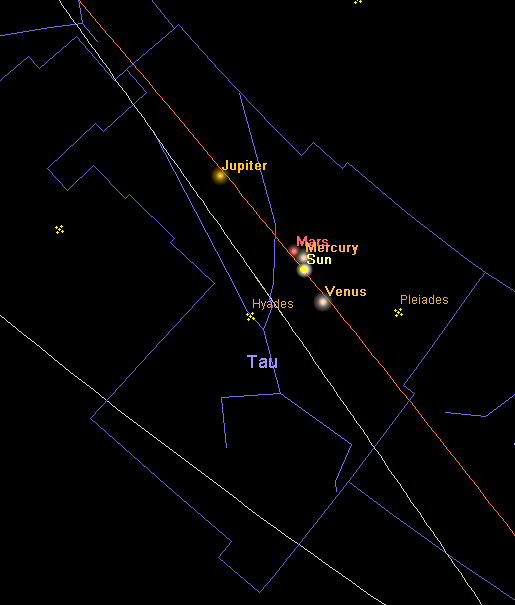 |
|
Credit:
Redshift6, North China,
9/5/1052. Massing of
Jupiter, Mercury, Mars, the Sun and Venus in Taurus. |
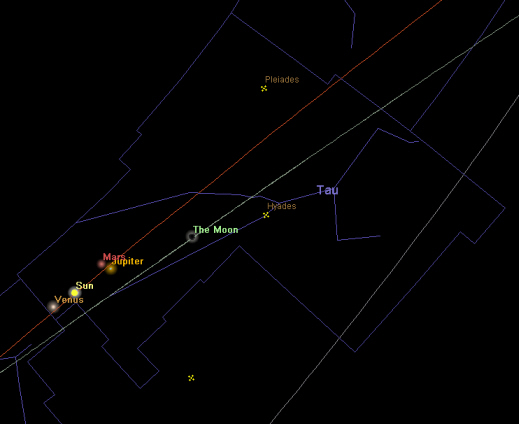 |
|
Credit:
Redshift6, North China,
30/5/1052. Massing of
Venus, the Sun, Mars, Jupiter and the Moon in Taurus. |
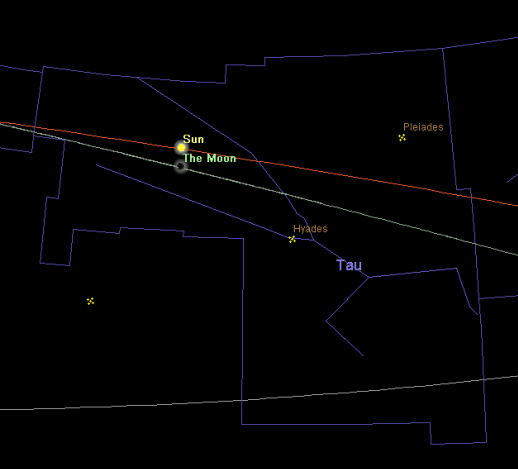 |
|
Credit:
Redshift6, North China,
21/5/1053.
Eclipse of the Sun (total eclipse but invisible from North China) |
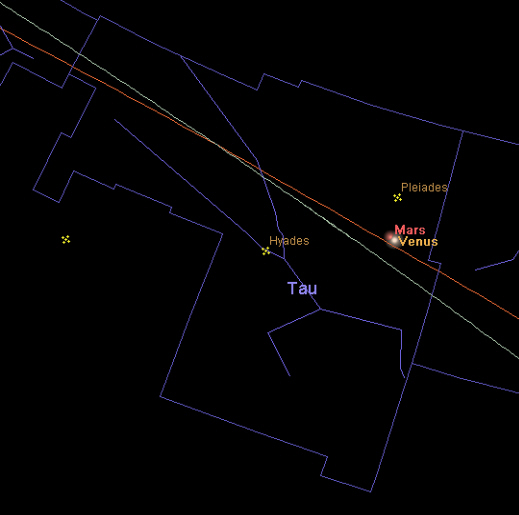 |
|
Credit: Redshift6,
North China,
5/4/1054 Conjunction
of Mars and Venus in Taurus. Just before the earliest possible
sighting by Ibn Butan. |
|
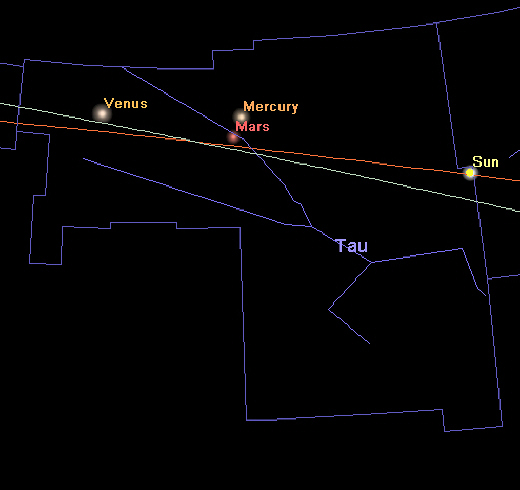 |
|
Credit: Redshift6,
North China,
26/4/1054.
Conjunction of Mars and Mercury. Venus next to SN 1054,
massing of Venus, Mars, Mercury and the Sun in Taurus. Around
the time of a possible sighting of SN 1054 from Ireland. |
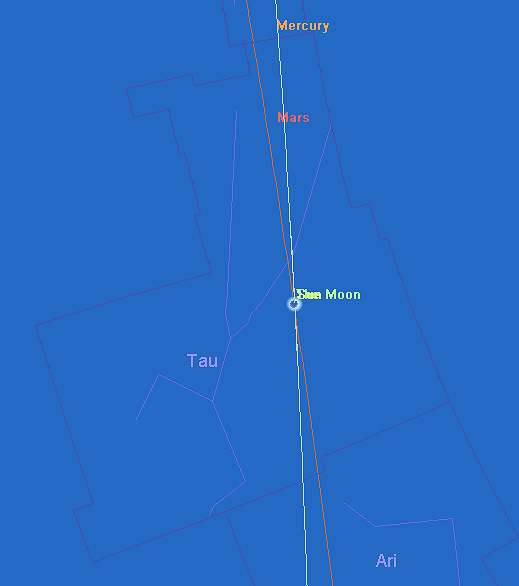 |
|
Credit: Redshift6,
Central China,
10/5/1054 at the time
of the total eclipse of the Sun. Massing of Mars, the Sun and the
Moon in Taurus. Mars next to SN 1054. Time of possible
sighting in China by Liao dynasty. |
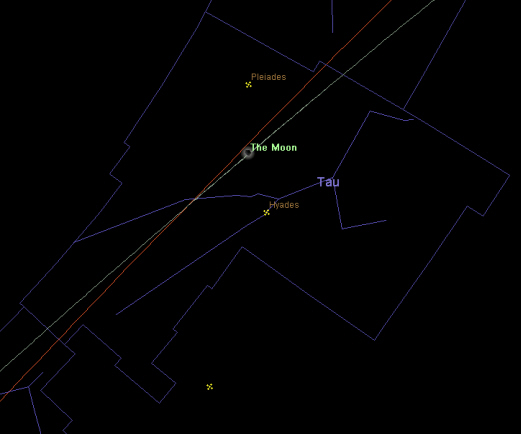 |
|
Credit: Redshift6,
North China,
4/7/1054 at the time
of the official appearance of SN 1054. Only the Moon present
in Taurus, near the Pleiades. |
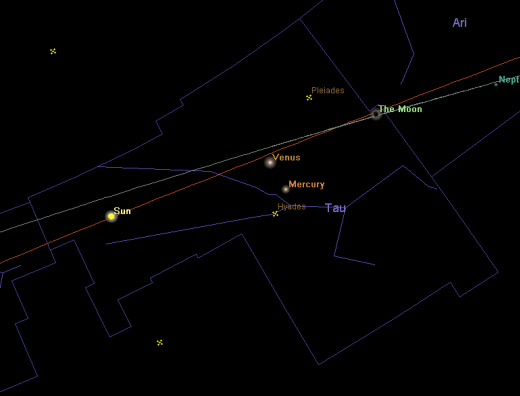 |
|
Credit: Redshift6, North China, 27/5/1055. Massing of
the Sun, Venus, Mercury and the Moon in Taurus. The Sun is
nest to SN 1054. |
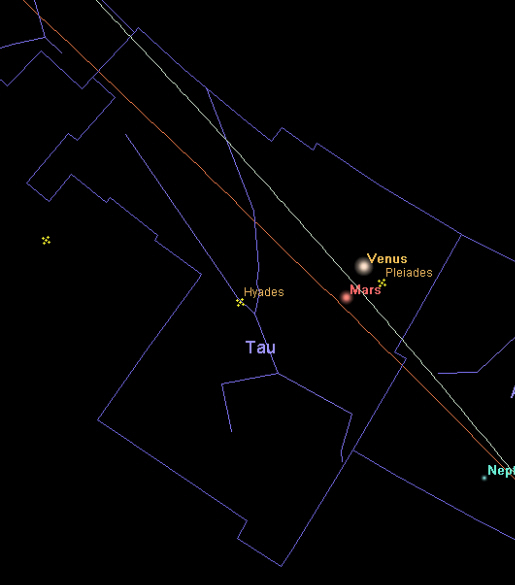 |
|
Credit: Redshift6, North China, 18/3/1056.
Mars and Venus in near conjunction in Taurus. |
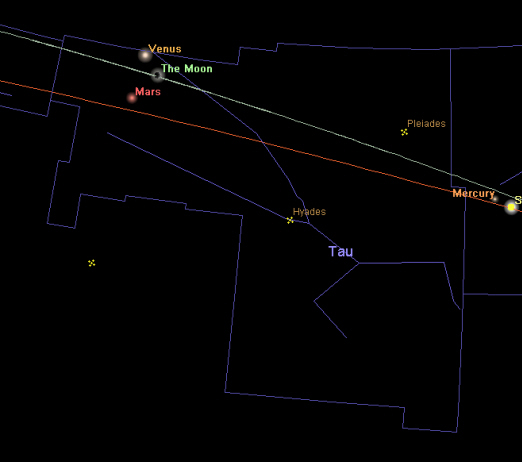 |
|
Credit: Redshift6, North China, 21/4/1056
Massing of Venus, Mars and the Moon in Taurus. Venus and Mars
in conjunction with the Moon and all next to SN 1054.
|
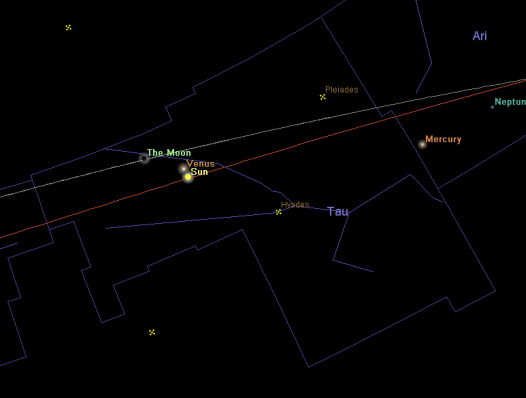 |
|
Credit: Redshift6, North China, 18/5/1056.
Massing of Venus, the Sun and the Moon in Taurus. Venus in
inferior conjunction with the Sun. |
Kepler and planetary
conjunctions
http://adsabs.harvard.edu/full/1937JRASC..31..417B
http://adsabs.harvard.edu/full/2000JRASC..94..174E
http://adsabs.harvard.edu/full/1949PA.....57..182S

Copyright © 2010 P. Han










